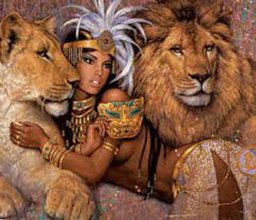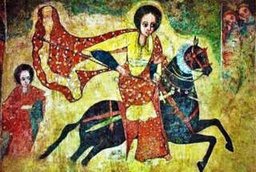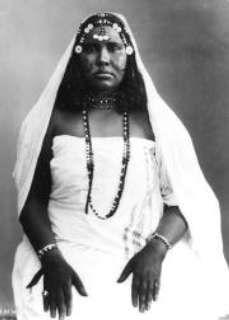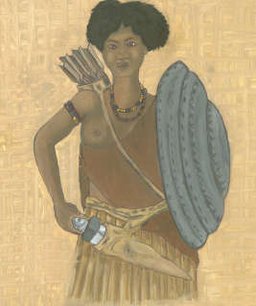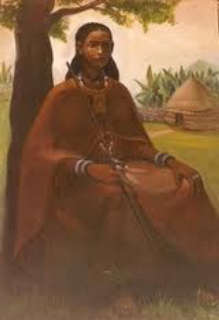Ethiopia in History
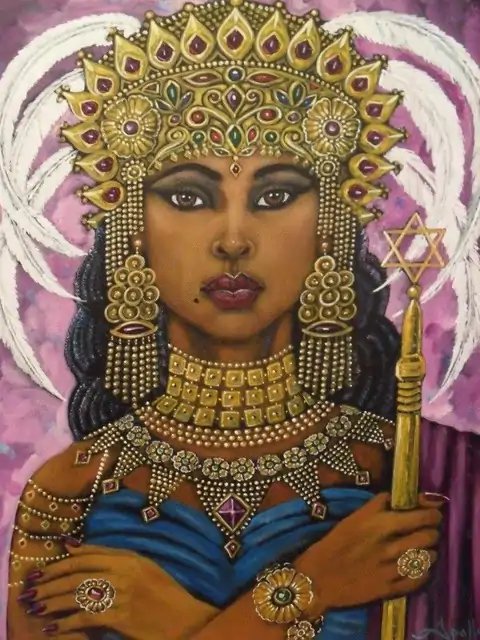
Ethiopia in History
Queen Yodit of Ethiopia: Understanding one of the greatest women powers in Africa
Alelign Aschale (PhD)
Introduction
When researchers zoom in on studying documents credited to the beginning of Aksumite Kingdom’s decline, female ruler(s) names such as Yodit became a “wait a minute, who is she?” discourse.
Her period is also categorized as the “Dark Age” of documents.
Of courses, internal sources are dearth and coin minting stopped.
Ruins of buildings and oral narratives kept the history of Yodit alive.
Out of such a Dark Age, factions of writers discredited Yodit’s period of rule as illegitimate in Ethiopian history.
Instead, they blamed the blameless as “the archenemy of Christianity and the Aksumite Rulers”.
Conversely, wasn’t it one of the periods of women enlightenments?
Her proper and regal names had been varied greatly.
In despising her identity and power, she is competitively known by many names and size of rule.
Her genealogy and manner is also appalling.
This appellational bewilderment put “them-us” in serious retrieval mystifications though there have been strong desires to unpack such proper, regal, genealogical, spatial, and temporal appellations of a powerful but mysterious queen.
Besides, the gender perspective of female rules has been put into serious investigations.
Hence, the aim of this chapter is to give a great focus on the elasticity of the synthesis-analysis, which has been an overdone analysis of details, using dissection of the contemporary subjects necessitated for the demystification Queen Yodit and her rule.
The study critically unmasked the implication and challenges the delegitimized status.
It contested the problems and questions of Yodit and forwarded the post-modern views of history.
Succeeding the ancient Kingdom of D’mt (Damat or Damot), Aksum Ethiopia had been one of the greatest empires of the time that incorporated Arabia, Nubia (and Meroe), Havilah, Ophir, Punt (including Libya), and the whole White Nile environs prior to the 5th century.
Gradually, Persian power rose, Islam expanded, and their resistance had been intensified in Arabia.
This emerging powers formed strong alliance, crossed the Erythrean Sea, and engulfed Aksum Ethiopia from its northern and eastern orders.
It began to disorient Christian power movements and ideological prisms.
Christianity learn to accommodate the new religion of Islamic dogmas and practices beside paganism, traditionalism, and Judaism.
In the contemporary Agäw society, Christianity reached its apex of worship, but the some communities of Ethiopia who had been living in the northwestern parts could have worshiped Judaism.
They had been worshiping Judaism for reasons that Christianity had never been properly evangelized in the area.
Consequently, they refused to accept Christianity and remained aloof with the Old Testaments.
Due this disparity, both Christians and Jews used to get engaged in categorical conflicts and civil wars.
Out of this volatile war zone, a skilled female warrior arose, took the spears and swords, and began to mobilize mixed forcesː experienced and youth power around her expanses.
By the east, Islamic forces began to cuddle back the Christian Aksum into the interior.
The Christian power of Aksum had been squeezed in between the two growing powers.
It is used to be narrated that Yodit was the most beautiful Princess who had a very promising future at the Aksumite court with the greatest wisdom and justest personalities.
Nevertheless, she had been accused of a precious treasure of theft by one of her jealous nephews and closer relatives.
Consequently, Princess Yodit was forced to flee her home country of Aksum which many believed that it was the western side of Aksum.
This was the beginning of Yodit’s “rebellious” acts.
This had helped Yodit to build a formidable army constituting the youth and the experienced power from Agaw, Semien, Meroe, Felasha (supposed to have a Jewish genealogy), and the cast groups who were classified as idol worshipers and pagans.
The princes was put in exile to the western side of the royal seat of the Aksumite kingdom.
In exile she rose to power and mobilized one of the mightiest army in Africa.
Later, she had laid waste the kingdom of Aksum.
She had restructured the Christian royal system of patriarchal monarchism.
This was one of the strange phenomena in Ethiopian history.
The strange narrative of Yodit’s raise from a fall in exile and the devastative retaliation against the Aksumite royal power continued to invoke terror and scare in the minds and hearts of many Ethiopians for many centuries.
Yodit is still known by the manners of vengeance and historically categorized as the “archenemy” of Christianity and the royal family in Ethiopia.
Was she really the archenemy of Christianity, the royal family and the civilization in Ethiopia?
Who was Yodit?
What was her epicenter and horizon of rule?
When was she the ruler of Ethiopia?
What were her true reign and proper names and the true genealogy?
Is there an answer closer to truth for each question?
The following paragraphs dwell on attempts to demystify the mysterious ancient Princess, Rebellious, or Queen Yodit of the post-Aksumite kingdom of Ethiopia.
Deciphering Queen Yodit from Appellations
The Alternative Proper names
Queen Yodit is introduced to the literature in many names.
Names such as al-Haghouya or Bani al-Haghouya (Halévy, 1889; 1896) is related to the Agäw origin of the name.
The name al-Yahoudya by Guidi (1888) connects the appellation to her Jewess genealogy.
Name such as Bahi al-Hamusa, Bani al-Damutah (Rossini, 1928, p. 286), or Bani al-Hamuya (Sawirus, 1948, p.171; Taddesse, 1972, p. 38; Tabor, 2015, p.87) are connected to her Damot genealogy.
The Arabic references of “al” and “Bani/Bahi” to her names are simple calling (morphemic) extensions.
These nominal references, besides name obscuring, attempted to link Yodit’s genealogy to Agaw, Jew, Arab, or Damot.
The names al-Haghouya (the Haghouya) and Bani al-Haghouya (Bani Haghouya) refer Yodit as an Agäw queen in origin.
These are mispronounced names of her references to the Agaw genealogy.
However, appellations such as Bahi al-Hamusa (Bahi the Hamusa) and Bani al-Hamuya (Bahi the Hamuya) connecting her origin to the Damot Kingdom.
The above names are coined by foreign writers.
The other name that foreign writers used is Ela Gudit.
Ela is an entitling prefix added to many of the Aksumite kings.
Ella is alternatively spelt as Ell, All, Al, Ila, Illa, Ill, Alla, Ela, or Ala which seemed to signify similar power and status of royalty (honorifics).It
was a power title unique in the hyperboles. The
etymology of the word was related to the signification of god, goddess, saint, light, all, completely, other, or beautiful, fairy, nice, or caring (Campbell, 1996). Ella
has many etymological and meaning variants in many languages (Campbell, 1996). Campbell
explains that Ella is a feminine entry with usages in English, Swedish, Norwegian, Danish, Finnish, German, Greek, Hebrew, Hindu, and many other ancient African languages. I
claim that the origin of this word is Ethiopia which is Africa.
Many literatures signified Queen Yodit with alternative names.
Names such as እሳቶ (Ǝssato) or አጼ እሳት (Aṣé Ǝssat, ‘Emperor Fire’) in both Gə’əz or Amaric languages as mentioned by Ludolf (1682) and Täklä Ǝyäsus (2016) are attributive names.
Ǝssat is an attributive label to the queen as “unchastity, sacriledge, and avariance [sic]” according to Ludolf (1682, p. 167).
ጋዕዋ (Ga’əwa) is the other name in Ṭəlṭalor Afar language.
ጉዲት (Gudit) or ጒዲት (Gwedit) is another alternative name of the Empress in Amaric language to signify her reign as “the bad” one.
Sergew (1972) and Andersen (2000) agreed that the name Judith is the Tigrigna version of Queen Yodit’s name that become the key appellational disorientation in history.
The names Tärda’e Goméz who is supposed to be the wife of emperor Mära Täkla-Haymanot and Princess Mäsobä Wörq who was also the wife of emperor Lalibela are correlated with the names of Queen Yodit (Ludolf, 1682).
Ludolf cited and correlated this names in attributive manners to her “victorious” nature.
He agreed that Yodit means victorious.
According to Bruce (1790), Trimingham (1952), Rossini (1928), Sergew(1972), Andersen (2000), Belaynesh, Chojnacki and Pankhurst (1975), Henze (2000), Tabor (2015), and Däsé (2016), the alternative addresses of recursiveness with names such as Emperor Fire, Queen Regnant Gudit of Bani, Queen Regnant Gudit of the Demot, Yodit of Damot, Queen Regnant Yehudit (in almost all Jewish sources), or ዮዲት ጉዲት in attributive discourse put many readers into confusion to exactly pinpoint the Queen.
Williams & Finch (1984), Kaplan (1995), and Fəsəha Yazé (2011) claimed that Yodit Gudit was a synonym for “a black” Hebrew Queen named Esther [Astér].
She was also known by the name አስቴር (Astér).
Aster could have been her first name and Yodit could be her regal name given when she ascended to the throne.
Her names create confusions of geography, genealogy, period of reign, and her manner of rule.
In a schema of nomenclature confusion, a Queen of ancient gallantry named Akko Mänoyé of Boräna (aka Akkoo Mannooyyee), Tuläma, and of Käräyu was believed to be rule Ethiopia.
Tabor (2015) and Ibsa (2015) confirmed that the name correlation with Yodit could be a historical miss-signification to Bani al-Hamwiyha of Yodit (though was also an Oromo Queen).
Likewise, a warrior Sidama Queen named Furra was associated to the period of Queen Yodit with her capital situated at Ku’əbar (Bruce 1790; Crawford, 1958; Pankhurst 1961; Huntingford, 1965, p.6; Bairu 1987).
This relationship could either be a substitution discourse or a discourse about the same subject of a powerful queen of Ethiopia whose common name could be Yodit.
The two names are very difficult to associate in time and space.
It is difficult because there is no any linguistic clue to associate Furra with Yodit.
The possibilities are Furra was a name given to Yodit by the Sidam people when she began included the area of the Southern Ethiopian region.
In this case, Furra is Yodit.
The Regal Names in Array
Yodit has also been given different names of a regalia and power accord.
Alphabetically analyzed, the first one is Akkoo.
Akkoo in Affan Oromo means Grandmother.
Ibsa (2015) wrote one of the “legends” of Akkoo Mannooyyee using oral narratives explaining that her mysterious abilities and wisdom of rule was very indigenous to Ethiopia.
Alternatively, Akkoo Mannooyyee was an Oromo woman of wisdom and power who established a formidable matriarchal rule in Ethiopia.
She is described in the “oral legend” that the queen mother used to love and trust short men.
Yodit is also know by the throne title of Aṣé.
It is true in history that the Emperors and the Empresses of were the sources of all power configurations in an empire, and they embodied titles of Kings, King of Kings, Queens, Queen of Queens, Queen of Kings, or the ‘Aṣé.
Aṣé, Aṭe, Ǝṣ́é, Ǝté, ’Aṣ́é, or Haṣé is intended to mean Your Majesty which operationalized ideologies of Magnificence, Grandeur, Glory, Radiance and Marvel.
Certainly, the pre-fix of the royal titles such as ’Aṣ́e had been favored by many kings and king of kings to inculcate distinct genre and style and to operationalize masculine regal power (Kidanä Wäld, 1956; Aman, 2014; 2016).
Nevertheless, Täsfa (2015, p. 91) believed that the first Ḥaṣé title known in Ethiopian history was claimed by Emperor Yəkunno Amlak who began to rule medieval Ethiopia in 1270 AD.
Empress Yodit had names such as Bahi, Bani, Batya, Batiya, or Bati.
According to Trimingham (1951), Cerulli (1971), Brahkamber (1977) and Insoll (2003), these appellations were abstractedly equivalent to the status of her majesty, your majesty, the great royal lady, the great lady, or your highness in the “legitimate” queens and kings’ ruleship.
That is, the honorific titles such as Bati, Bari’al, Batiya, Ba’ati, Ba’itya, Bahi, Bani, Ba’tya, and others of a symmetry have been ancient royal names with their meaning referring to lady, royal highness, your honor, your highness, and/or your majesty.
Ella with the alternative spellings had also been in use as a name of regalia to Queen Yodit.
Its historical connection to the many of Aksumite rulers is fascinating to make a conclusion that Yodit could rose out of the Aksumite genealogy than the other alternatives.
The feminine entry of Ella and its many variants is the honorific of royal power and majesty.
This name is an anti-node to the discourses that struggled to deny the legitimate ruleship of Queen Yodit.
Yodit had also been known by the legitimate royal titles of Princes and Empress.
Apparently, Princes is the honorific title to the daughters of a king, a queen, or an Empress.
Likewise, an Empress could be the name of a queen regent, a queen regnant, or a queen console.
Many corrupt texts never dared to attribute the status of Empress to Queen Yodit because she is cornered as a usurper queen.
However, records of a multiplicity also used the regal title of Empress to Queen Yodit.
One of the competing regal titles was also Queen Yodit whom the overlexicalized discourses associated to the rulers were some such as a demolishing ruler, an anti-Christian, a pagan, an Ethiopian Jew, a usurper of royal system and structure in pride and emptiness, and she was underlexicalized as a queen in queendoms personalities to lead the people in mass granted power.
Yodit is also known by the title Queen Regnant.
The appellation Queen Regnant, to mean Empress Regnant, was used in the ancient times to scale up the sovereign power of queens who ruled in their own right over an empire and mobilized a huge army under their closer command (Reisner, 1922; Getachew Haile, 1984; Rubinkowska, 2007; Weissberger, 2008).
The rare regal title of Yodit was Ras or Ras Ela.
Ras is usually reserved to the patriarchy, and it is very uncommon to use Ras or Ras Ella for the matriarchy in the system and structure of the matrimony.
However, Yodit was known by these similar names.
Ras Ela, I supposes, is a double regalia because Ella itself is a name of higher regalia in the ancient periods.
The appellation “Ras” has never been recorded in Ethiopian history as a title to higher rulers at the power and attribute of queens or kings.
No matter how rare is the record, Yodit has been known by the regal name of Ras.
Apparently, Yodit as a royal title of honor and power was denied of recognition in Ethiopian history.
Its negative association to a usurper, fire, or a simple ancient fairy nature are exclusionary discourses and power de-legitimizations.
These nomenclatures contributed in taking sides to who was who.
Demystifying Yodit’s Period and Space of Reign
The magnificent period and space of rule of Queen Yodit was always ideologically segmented as one of the “Ethiopian Dark Ages” in history (Sergew, 1972, p. 113).
It is a dark age because there are no ample evidences to trace her true history.
However, this does not mean that there are no documents that can hint her history and territory.
Her period of rule ranges between 780 and 1000 AD, and her spatial influence extended to Sudan and the ports in the north and west, to Dahalak islands in the northeast, to Damot in the southwest, to the Sidama environs in the south, and to Somalia in the east.
Perhaps her multiple names could be due to the renaming of her rule and personalities as she moves into these areas at different periods.
Scholarly Recorded documents by Bruce (1790), Rossini (1928), Belaynesh, Chojnacki and Pankhurst (1975), Trimingham (1952), Sergew (1972), Henze (2000), and Däsé (2016) affirmed that during Aṣ́é Wededem’s (aka.
Wudemdem, ‘Aṣé Danile, Emperor Ḥaṣani, Ḥaṣani Daniel) reign which stretches between ca.780 and 790 or ca. 785 and 795 or ca. 792 and 822 AD, a powerful woman rose to power in Ethiopia and assassinated the emperor (Henze, 2000, p. 48).
A strong discourse node that supported this claim was put by an Arab geographer named Ibn Hawqal stressing:
As regards to Abyssinia {al-Habasha}, for many years it has had a woman as its ruler.
It is she who killed the king of al-Habasha who was known under the title of al-H̩ad̩ani (Eth.
h̩ad̩é), and continues to this day to dominate [she rules with complete independence in] her own country and the neighboring regions [the frontier territories] of the land of al-H̩ad̩ani in the West of Abyssinia [al-Habasha, Aksum].
It was a vast limitless country, rendered difficult to access by deserts and wastes (Trimingham, 1952, p. 52; emphasis added).
Ibn H̩awqal //Abu’l Qäsim described the mighty woman ruler of al-Habasha [which is Ethiopia] as a very much powerful and competitive one in the western frontiers of the previous royal seat, but the timing he mentioned and the Ethiopian king list that claimed as the end of Aksumite dynasty don’t much with his narration.
Hawqal’s description carried some vital discourses.
Each bit of phrase connoted that a queen subject was ruling other areas of “Western” Ethiopia before Emperor Ḥaṣani.
Her seat of power was not in Aksum customarily, but it was situated in the West {of Aksum} which was “her own country”.
The west could be the western Ethiopia of the time.
She ruled the vast and more extensive size of the country in her time, and this area could be inclusive of present day Sudan and Ethiopia.
This leads researchers to assume that she had organized her own “latest” army from her own country (though this is still perplexing to define the border).
This could have been the “rendered difficult to access by deserts and wastes” part of Western Ethiopia and Sudan as far as the north.
That could be part of Ethiopia in those contemporary periods.
Emerging deduction would be a revenge for the abandoning of Kandake rights and benefits of women in Western Ethiopia before Yodit’s time.
Between 969 and 970 AD, a Yemenite king, as Munro-Hay (1991) and Williams and Finch (1984) discovered in an Arabic text, sent a Zebra to the King of Iraq which he had received it as a gift from a Queen of al-Habäša who was identified in time and space concordance as Queen Yodit.
This is a syntagmatic clue that strengthened evidences that her power had extended into forming a strong tie with the kings of Arabia and Asia via eastern Ethiopia.
Picking another non-recursive narration version that states that in 846 AD a powerful ruler named Ela Gudit, Nəgəst Gudäta, Akko Gudäté, or Illa Giudit of Aksum who took the power from the patriarchy and departed with other emerging powers in weakening the old system and aligning hers with other emerging powers of the empire (Sergew, 1972).
The narration explained that the powerful female governor continued to rule, with iron-fist, over the vast territories of historic Ethiopia up to 885 AD for 39 years wiping out all genealogical families of the pre-established monarchy in Aksum.
The fundamental equipoise of the period was that there was another Queen named Yodit.
Highly recursive was the records of Queen Regnant Yehudit who ruled over Ethiopian empire for 40 years between 850 and 890 AD (alternatively, this period is found dated as a rule between 890 and 930 AD).
The names endorsed to this period are al-Yahoudya [Jews, Ignazio Guidi’s (1888) term] and al-Haghouya [Agäw, Joseph Halévy’s (1889) term)].
As credited in countless sources, she overthrew King Gedajan (r.1, 849-850 AD, aka.
Gedžɑ̈n, ‘Aṣé Hezbenagn or Hezbänañ) and caused the Aksumite Kingdom (the “first Solomonic Dynasty”) to decline in lieu of an Ethio-Judaic {Jewish Pagan} rule to flourish over Ethiopia.
She was also believed to be a powerful Queen of a mixed genealogy who established a very Kushitic-Judaic rule over Ethiopia.
This rule of hers had been casted as an “illegitimate” rule over the land of the Solomonic genealogy.
This is very important to generate the thesis that Yodit could have paved the ways for the reemergence of another powerful dynasty which had been labeled as the “usurper” Zagwé Dynasty of the Moses’ genealogy.
Why is Moses’ genealogy a usurper in Ethiopia?
Wasn’t is acceptable that Moses wrote and implemented Christian laws in the world?
The narrative iteration of her genealogy as an Agaw descent (or a Fälaša Agäw) compelled may historians to concluded that Yodit establish the first Agäw (afterwards, Zagwé) Dynasty in the West of Aksum.
Why were the Agäw rulers categorized as usurpers?
Were they not included and functional in the royal system strongly?
Were the Aksum and the Agäw prisms of rivalry?
If Yodit is the first queen to establish the Agäw rule, this would push back farther the reign length controversy of the Zagwé Dynasty.
The period of reign for Queen Yodit is especially confused in the historicity (Alelign, 2018).
In one, the name Ras Ela Giudit Terda’e Gomaz Yodit was ruling Aksum Ethiopia between 846 and 885 AD.
In other, Queen Gudit of Ethiopia was the ruler in about 900 AD.
In about 950 AD, there was a powerful Princess (Empress) Yodit of Agaw Ethiopia who rule the area.
Alternatively, in about 980-1000 AD, there was a queen named Queen Gudit of Bani al-Hamusa of Damot who ruled Ethiopia in the South of the Nile and the South-west of Shava (Shewa) Ethiopia.
Rossini (1928) also argued that a Queen by the name Gudit was once the most powerful queen in the kingdom of Damot in certain Southern parts of Ethiopia from Aksum.
This scholar mentioned a certain Queen Regnant Gudit of Damot {Demot} in Ethiopia.
She was also named as Queen Regnant Gudit of Bani / Bahi al-Hamusa.
Alternatively, Crawford (1958) claimed that the region was Sidamo of Southern Ethiopia, and Yodit was a Queen raised from this area of the Sidama people.
Here Kingdom was situated south of the Nile River and South-west of Šäwa province.
She could have been a rival queen in another kingdom [of Damot] of Ethiopia (fl.
ca. 980–1000 AD).
She also attacked the Northern part of the Ethiopian Kingdom / Dynasty (the Aksumite Kingdom and the Zagwé Dynasty).
Nevertheless, as H̬əruy (1999) and Ǝrqihun (2016) pinpointed, the Šäwa area had never been under her enslavement rule.
This is a reconstructed discourse by later time writers.
Through the exploration of historians such as Williams & Finch (1984), Kaplan (1995), and Fəsəha Yazé (2011), the claim is that Queen Yodit Gudit established the first Fälaša-Jewish dynasty that ruled the northwestern Ethiopia between ca.950 and 1260 AD.
What is intriguing, beginning from about 1000 AD, there was another powerful leader (ruler) by the name (Queen) Badit bint Maja of the “Politically Organized Islamic Society” in the eastern Islamic provinces of Ethiopia (Mantel-Niećko & Nosnitsin, 2003).
It was an Islamic rule based on Mohammedian ideologies and provincial factions lead by Imirs and Sultans.
In space and time congruence, Furra was understood as a ca. 850 AD century powerful queen of the Sidama people of southern Ethiopia (Rossini 1928; Munro-Hay 1991) though Ibsa on his online text took the period of rule back to the periods of Kandakes’ rule in Ethiopia before 308 AD.
A posterior from the roles and practices of Kandakes, Yodit could have been a glorification title to the ruling Queens of the time over Ethiopian empire though it had been overburdened by the long established patriarchy and stiff Theocultural practices.
By implication, Yodit could have been assigned as a ruler of a certain state before she became the rebellious one against Aksumite rulers.
The Genealogy of Queen Yodit
The genealogy of Queen Yodit is a perplexing history, and it is a quest for truth from a critical endeavor.
A study of multiple claims about her space and period of rule and appellation varieties become very uncertain to take a stand on her genealogy.
The following points explain this uncertainty.
It has become convincing that the name Akko Mänoyé is an Oromo origin in its etymology.
The Borana and Gujji Oromo tales about bara akko haa manooyye—the era of grandma Mannoye or simply the Manooyee is a parallel (or same) history of Queen Yodit.
Though the period of rule for Akko Mänoyé usually dates back its beginning (ca.
308 AD) and comes forward in its ending (ca.
16th c.), there are tendencies of correlating her rule with Queen Yodit.
That means, Queen Yodit could be an Oromo of a Kushite genealogy.
The history of Akko Mänoyé has never been studied carefully, but her rule is widely known the Oromo oralities as Nəgəst Gudäta as Akko Gudäté.
Yodit who was named Astér was an Agaw, a Jew (Felasha), or a hybrid.
Dästa Täklä-Wäld (1970) points out that Yodit is short form of Yəhudit (“the Jewess”), and the name may thus have been given her as a nickname (an epithet).
Williams & Finch (1984), Kaplan (1995), and Fəsəha Yazé (2011) claimed that Gudit was a synonym for “a black” Hebrew Queen, a Fälaša (migrants from Israel and Aksum who settled in Səmén/Säménoy), named Esther [አስቴር-Astér].
The Säménoy, which included West of Aksum (Šəré, Enda Səllassé, Wälqayt, Janamora, Ras Dejen, Däbarq, Mätama, Humära, Ṭägädé, etc.) is a historical place of settlement for the Fälaša.
There is a uniform and long-established tradition that Yodit was a “Jewish” and an Agaw, and this key tradition cannot be easily rejected.
Astér was both a Fälaša and an Agäw hybrid.
Halévy’s (1889; 1896) name of al-Haghouya is a reference to her Agaw genealogy.
Täklä-Ṣ́adəq (1990) and Bartniski and Mantel-Niećko (2017) wrote that Yodit was first called Astér (“Esther”), and her father was called Gédéwon (Gideon) who was a Jew migrant.
It is important to mention that the name Astér had never been known and used after the Queen destroyed the Däbrä Damo Monastry.
As the narration continued, Astér got married to a Christian ruler, perhaps around a province of Lasta and Roha.
Her husband’s name was Zär’a Ya’qob.
He married her not knowing that she was from a Jewish family.
Struck by her irresistible beauty, convinced by her wisdom and belief, and smitten by her infinite love, he was wholly converted to her religion and become a Jewish.
Consequently, she arranged a unique ritual to convert his first Christian name (Zär’a Yaqob) into the new Jewish name called Sälomon.
In a closer narrative to the above, there is a story that pronounces that by the end of Emperor Gedajan’s rule (849 - 850 AD) which is supposed to mark the decline of Aksumite Kingdom (the First Solomonic Dynasty in Ethiopia), a new version of Ethio-Judaic rule emerged.
This Ethio-Judaic rule was established by Queen Yodit.
This narrative intends to claim Yodit’s origin as a Judaic.
This hard-seated narrative looks a historical truth, and no one will listen to you except this alternative history.
However, there are many options of connecting the queen’s genealogy in history though they are credited as legends, myths, or fallacious histories.
A good number of historians and anthropologists believe that Queen Yodit was a half Italian with a great assumption that perhaps is linked to the tradition of calling the Bejja tribes of Rum as Rome.
Doresse (1959) commented that these writers pronounce a small probability of connecting her father’s name as Italia with appellational traditions of rhyming Rum as the Amaric ሮም, ሮማዊ, or ሮማ and the English Italiya or Italy.
That is, Queen Yodit is a Bejja and her father is from the Rum tribe.
In Bejja genealogy, there is a tribal branch called Rum, which is alternatively pronounced as Rome, Romé, Rom, Roma, Romawi, or Romawiyan (Doresse, 1959).
These tribes had been famous in poetry, war, and multiple arts.
The Bejja had been known in legends, myths, and oral histories as fearless warriors and the original people of Africa Ethiopia.
These Kushites used to incur much trouble on the Ethiopian emperors and ruled the vast territories of northern Africa and the horn.
The genealogical correlation between Queen Yodit and Queen Furra of a Sidama warrior prevails in many south-fan legend collectors, story narrators and history writers.
Rossini (1928), Rike (2014), Mitike and Yri (2017), and many more Ethiopian writers tend to agree that Queen Furra was a Kushite Sidama which could be traced for her material studies (e.g. mountains) and oral histories.
Queen Yodit could also have an Afar or a Bejja blood.
One of the names of the queen was ga’əwa (gawa), to mean “ruthless”.
However, this appellation could either refer to an Afar or a Bejja queen or a different queen who was fierce enough against the people of Afar and Bejja.
She was also a Damot Queen (Rossini, 1928; Sawirus, 1948; Taddesse, 1972; Tabor, 2015) understood from her appellation of Bahi al-Hamusa, Bani al-Damutah or Bani al-Hamuya.
What is important here, the location of Sidam kingdom of the period was identified in multiple spatiality.
The one is correlated to the Damot Kingdom of Gondär, Gojjam and South of Abbay River (of which some of the districts were Damot, Motta, Säräbé, Däräbé, Gafat, Sidamo, Endägäbtän, Jamma, Gambino, Wäräb, Šäšänq, Ennarya, Sat, and Bizamo) which was inhabited by the people of Gafat and Gärnbo, and the other is associated to the Damot Kingdom of Eastern and Southeastern Ethiopia as far as southern Yemen and the whole of Aden environs (Rossini, 1928; Tadesse, 1972; Fəssəha, 2011; Täklä ’Ǝyäsus, 2016).
In other narrations, it is written that Yodit’s genealogy comes down from the Aksumite Kingdom because she was identified as the granddaughter of Demawedem // Wechem Asfare who ruled Ethiopia between ca. 790 and 820 AD (Sergew, 1972; Fəssəha, 2011).
There is another loose interpretation which tended to associate Queen Yodit with Tärda’e Goméz Yodit (aka.
Tärda’e Goméz, Tərdé’a Goméz) who was documented in multiple sources (e.g. Huntingford, 1965; Mordechai, 1970; Sergew, 1972) as the granddaughter of Emperor Wudəm Asfäri (r.30, 795-825 AD [ca.790-820 AD] and wife of Emperor Zagwe (Mära Täklä Haymanot).
This is the claim that tried to link her blood to the Aksumite royal family and Solomonism.
In Azəwa Maryam manuscript (MS.115, p. 203), it is recorded that “Gudit is the daughter of King of Kings Ayzur of Aksum (an Emperor of Aksum who was suffocated by the admiring crowd the same day as he was crowned - since then it became illegal to approach an emperor) and Queen Console Mikia Maryam”, and their country was ኃኃይሌ (Gz.), H̬ah̬aylé.
The location of ኃኃይሌ (Gz.), H̬ah̬aylé is found in present day environs of Adəwa (Adwa) of Tigre/Təgray region.
This account would figure two contrasting ideologies.
A royal daughter “rebelled” against the royal family cluing Aksumites’ exhaustion of the long-established patriarchy, or she was a victim of the gendered (cultural) marginalization or critical heresy by the royal scribes in silencing certainties about her.
Queen Yodit is repeatedly identified in many texts as a “rebel queen”, and this is a clue that the queen was a loyal one to the Aksumite emperors who used to pay tributes and serve the emperors of the time with loyalty.
Badit Bint Maya could be another Gudit/Yodit Queen of a tribe / a sub-state-entity in Ethiopia in those pastoralist areas of the period.
The daughter of St. Emperor Lalibela was also named Princes Yodit // Lə’əlt Judith (Rossini, 1943; Belaynesh, 1975) whom Emperor Nä’akuto Lä’Ab strove to abduct her.
That is, Yodit could have a genealogical connection with the Zagwé rulers and she could be an Agäw.
Her genealogical diversity carried historical clues of competition between the name and the subject of Yodit.
Manners and Figures of Queen Yodit
A towering figure in Ethiopian history who is known to the world by different names such as Astér, Yodit, Furra, or Mänoyé has been imagined by many writers and commentators in both positive and unenthusiastic representations.
Her manners and figures are so perplexing.
In one, Yodit was an extremely beautiful daughter of a known charismatic ruler of northwestern Ethiopia by the name Gedeon (aka, Gedion or Gédyon), and “she was married to Zenobis, the son of the King of Šam” (Crawford, 1958, p. 81).
In appreciation, Bruce (1790) described Queen Yodit as a “woman of great beauty”.
Crawford (1958) also represented her as a queen of the greatest talents for intrigue at Ku’əbar.
The contesting discourse to this claim was that she was a strong and proud devotee to an Indigenous Ethiopian religion (faith); therefore, she had developed a strong hatred towards the intrusion, inculcation and operationalization of a Judeo-Christian religion in Ethiopia.
The name Yodit also means “very beautiful” (Doresse, (1959).
Trimingham (1952, p. 52) mentioning the 10th century Arab geographer Ibn H̩awqal (aka Abu’l Qäsim) designated Queen Yodit as the mighty woman ruler of al-Habasha, and she was an inferno warrior who was capable of killing an Aksumite king.
Yodit is described by Molvaer (1998) “a fierce and destructive queen” (p.47) who was matchless in wars and administrative techniques.
In many other sources of a negative other representation, it is possible to repeatedly come across with references of Queen Yodit as Isato, Gudit, Gudäña, Gudäñaytu, Isato Gudit or Gudäñit.
In Ethiopian dictionaries, Isat refers to “fire”.
This correlation of “fire” with to Queen Yodit elastically connotes her nature to a space of “fire and brimstone” which is by implication referring not only to her destructive actions of the Churches, her treasures, her wisdoms, and people, but it also defines the Queen as an earthly agent of the devils who was sent as a divine judgment in subduing and punishing Ethiopians who had been turning away from the laws and worships of God (Molvaer, 1998).
The references of Yodit rhyming in as Gudit, Gudäña, Gudäñaytu, Isato Gudit or Gudäñit added negative extra meanings to her badness and flaws.
Gudäñit is also representing queen as “the freak, the monster, the unnatural or unusual or surprising or strange one.”
As a result, she has also been negatively epitomized as ጋዕዋ (T̩əlt̩al, Afar)-Ga’əwa, which meant “dreadful beast” in the language, እሳቶ-Ǝssato (Am.), “blazing”, ጉዲት-Gudit (Am.), ጒዲት-Gwedit (Am.) or Judith (Tig.), which have approximately connoted sociocognitive discourses of deficient, Mongol or “idiot”.
She was dishonored as Yodit-Gudit which means “Yodit the bad” or Ǝssato to mean “the fire”, “the blazing ruler”, or “an invader of her own honored people” by many Christian documents.
In deconstruction, Yodit was a royal title to many Queens in Ethiopia of the contemporary.
In reconstruction, Yodit was a powerful Queen of Queens and Kings over the vast Ethiopian empire, and her rule was a time when woman power elevated atop.
The pressure of theo-patriarchy and “legitimate” political power could have triggered the “Yodit” image to be an iconoclast to the Kings and Kandakes’ knowledge, ideology and power criteria, the reliable diachrony and contemporary diatopy.
So, she was given the high treason attributive nominations, and this is a retrospective semiotic clue that she was such a superpower queen of Ethiopia.
Bruce (1790), Leeman (2009), and Sawirus (1948) described Yodit as pagan-Hebraic leader of a matchless cruelty.
For Sergew (1972), Queen Yodit was a destroyer all the monument and artifacts of Aksum city, an archenemy of the Ethiopian churches, a cruel queen, a pagan ruler or Jewish “enemy” of the Aksumite royal family.
In every Ethiopian Christian tradition, Yodit or Judith has been considered as a “destroyer” of the Church’s Treasures and a “traitor” of Christianity who come from the Jewish kingdom {Felasha rule} (Sergew, 1972; Belaynesh, 1975; Andersen, 2000; Henze, 2000).
She was from an archetypally “the other” line of rule.
She attacked as far as the south-western Christian provinces of Ethiopia who has been marked as “warrior queen” and “conqueror of Ethiopia”.
She was an unsuccessful “Church rider” in search of the Ark of Covenant to take it back to Jerusalem.
She was believed to be the first Queen to establish a Kushitic-Judaic rule which was classified as “illegitimate”.
But she could have paved the ways for the emergence of another dynasty which was labeled as the “usurper” Zagwé Dynasty.
Many documents iteratively asserted that she was of an Agaw descent (or a Fälaša Agäw), and she is believed to establish the first Agaw (afterwards, Zagwé) Dynasty in the West of Aksum; i.e. the “usurper” bred another “usurper”.
Queen Yodit’s representation of a “very beautiful” figure could have been linked the assimilative illustration of her name with the apocryphal Biblical Judith found in Judith 8:7.
The verse explains, “She was beautiful in appearance, and had a very lovely face”.
The beauty of the Queen is measured as equal as Nəgəśta Azéb or Mäkäda known in the Bible as “the Queen of the South”, which is approximately referring the spatial history of “the South-West” direction of Ethiopia from Israel.
The Queen of Sheba was known in many scriptures as the one whose beauty is described in the national theological epic of the Kəbrä-Nägäśt as “matchless” (Brooks, 1996).
In either case, the Queen(s) has been imagined to be a historically cryptic figure, so she picked up tagging discourses of “dark age” and “silence” due to the hard mystification and disorder in the ethnic thread and text (source) manipulations of negativity.
The Queen has been regarded as the “archenemy” of the Ethiopian Orthodox Church, her Treasures and the devotees.
This was a female power which could compete with an established Sheba-Mənilək monarchic order.
So she was a rebel, a ruthless ruler, a genocider, a strong and proud devotee to an Indigenous Ethiopian religion (faith), Judaic, pagan, or a pagan-Hebraic, an African-Ethiopian, an Agaw, a Fälaša, a Sudanese, a Damote, an Oromo, a Sidama, an enemy, a victim of abduction attempts, or an Aksumite royal traitor.
Conversely, she was the wisest and the mighty woman ruler, irresistibly beautiful, a loving one, a matchless and inferno warrior, a queen of the greatest talents, and a strong and proud devotee to an Indigenous Ethiopian religion.
